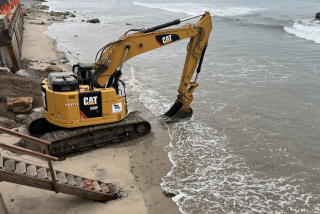COASTAL WATCH : A Living Argument for More Red Tape
Only days after Dana Point had appropriated $5,225 to have a biological survey conducted in a 9-acre coastal habitat on a huge parcel slated to be the site of a major new resort, the community development director noticed something peculiar--bulldozers had flattened the area.
The developerŌĆÖs response? Whoops! We were only trying to clear out some weeds.
Marie Patterson, a spokesperson for the South Coast Audubon Society, had another, somehow more plausible, explanation of what happened at the site where the Monarch Bay Resort Co. plans to build a hotel, luxury homes and condominiums: ŌĆ£These landholders are trying all sorts of things to get out of the possibility that their property could be listed as having endangered habitat.ŌĆØ
Amen.
This sort of situation, according to Madelyn Glickfeld of the state Coastal Commission, exists all up and down the coast. One problem is that penalties for destroying habitat are not stiff enough to really penalize violators. It is, in effect, cheaper for developers to do whatever they want, then pay a penalty, than it is for them to take the trouble to get the required permits.
Dana Point has an opportunity in this instance to get real restitution.
In the meantime, several bills now pending in the Legislature would address some of the larger coastal issues by imposing stiffer fines for the destruction of natural habitat.
More staff resources for enforcement are critically needed as well. Gov. Pete Wilson, to his credit, has promised to add several officers to the Coastal CommissionŌĆÖs one-person enforcement staff, which is charged with policing the stateŌĆÖs entire coastline.
In the Dana Point situation, the developer has taken the position that it is embarrassed by what has happened. It has even hired a biologist to study the site, with the aim of making amends by somehow repairing the damage. But as environmentalists are right to point out, once damage is done by a bulldozer it can take years to restore an area, even with the best of intentions.
Whether the developer fixes the area or looks to purchase substitute open space, it must have its feet held to the fire. And the city should be vigilant throughout development; there are already existing development-related concerns, such as how much traffic this resort will generate.
ThereŌĆÖs a larger lesson, too.
Developers often complain about the volume of red tape involved in environmental review. But hereŌĆÖs an example of why itŌĆÖs so important that oversight agencies and local planners keep minding the store.
More to Read
Sign up for Essential California
The most important California stories and recommendations in your inbox every morning.
You may occasionally receive promotional content from the Los Angeles Times.










